
With its long tail, this huge prehistoric-looking member of the cuckoo family reminded me of a pheasant. The bird is a weak flyer and clambers around in trees and shrubs. Unlike most Old World cuckoos this species is not a brood parasite. Note the long spike-like inner rear claw. All coucals have this and were formerly known as "lark-heeled cuckoos." This is the distinctive southern race C. s. parroti found through most of peninsular India and which has been proposed for recognition as a separate species called the Southern Coucal. It differs from other races by its distinctive all dark (not barred) juvenal plumage. It also has bluish gloss to its plumage (visible here on the nape) and a brownish cast to its forehead and throat evident in this photo. Five other subspecies are recognized, mostly in Southeast Asia. Digiscoped with Panasonic DMC-LX5 | Nikon FieldScope III | 30XWA | hand-held (no adapter)
References:
Payne, R. (2016). Greater Coucal (Centropus sinensis). In: del Hoyo, J., Elliott, A., Sargatal, J., Christie, D.A. & de Juana, E. (eds.). Handbook of the Birds of the World Alive. Lynx Edicions, Barcelona.
Rasmussen, P.C. & Anderton, J.C. (2005) Birds of South Asia. The Ripley Guide. Vols. 1 and 2. Smithsonian Institution & Lynx Edicions, Washington, D.C. & Barcelona.